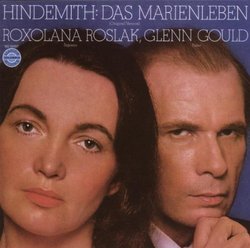| All Artists: Glenn Gould Title: Hindemith: Das Marienleben for Soprano Members Wishing: 0 Total Copies: 0 Label: Sony Bmg Europe Release Date: 9/3/2007 Album Type: Import Genre: Classical Styles: Chamber Music, Historical Periods, Classical (c.1770-1830) Number of Discs: 2 SwapaCD Credits: 2 UPC: 886971484427 |
Search - Glenn Gould :: Hindemith: Das Marienleben for Soprano
CD Details |
CD ReviewsRilke Rules: The Life of Mary... Sébastien Melmoth | Hôtel d'Alsace, PARIS | 10/06/2008 (5 out of 5 stars) ".
Beethoven had Goethe and Jeitteles Beethoven: An die ferne Geliebte; Lieder. Schubert had Novalis and Müller Schubert: Lieder. Schumann had Heine Schumann: Liederkries Op.39/Dichterliebe Op.48. Brahms had Tieck and Groth Brahms: Lieder. Wolf had Mörike Wolf: Mörike Lieder [Germany]. Schönberg had George Schoenberg: Lieder. Hindemith had Rilke--whose fifteen-part poem-cycle The Life of Mary was written in 1912, and set by Hindemith in 1923. As with Strauss and Schönberg, Gould had been advocating Hindemith from his youthful days in the 1950s. Just at that time, interest in all three composers had lapsed to a degree amongst critics and contemporary composers: Gould was on the cutting-edge of renaissance in resurrecting these artists' works. Withal, this 1977 recording was a project of love and respect. Moreover, some have wondered if Gould's relationship with the lovely Ukrainian soprano Roxolana Roslak went further than mutual artistic admiration: to be plain, GG's longtime producer Andrew Kazdin and others on the scene thought it likely that Gould and Roslak were lovers. Certainly some of the photos of GG and RR (shot by Gould's exclusive photographer Don Hunstein) have a very peculiarly intimate ambiance not seen in any other photos of Gould with anyone else. *[Note: Gould's tremendous artistic gift (combined with his dry white-bred Canadian upbringing) fostered in him a discomfort with (or in) his own body which lasted his entire life. During the "free-love" '60s & '70s, GG remained isolated while painfully aware of the youth and beauty of eros around him. Hence this affair with Roslak was a delicate late-bloom in his love-life: she must have been a very exceptional person in many ways.] In any case, the artistic combination of Gould and Roslak proved to be a wonderful match for the realization of Hindemith's song-cycle: the soprano's lovely, long-arching vocal lines are perfectly punctuated by the pianist's secco-détaché technique and Hindemith's sewing-machine rhythms. This cycle makes an excellent book-end to Schönberg's The Book of the Hanging Gardens. . Hindemith: The Complete Sonatas for Brass and Piano Glenn Gould Plays Hindemith's Piano Sona Hindemith: The 3 Piano Sonatas Hindemith: Das Marienleben; Krenek & Strauss: Lieder ." |

